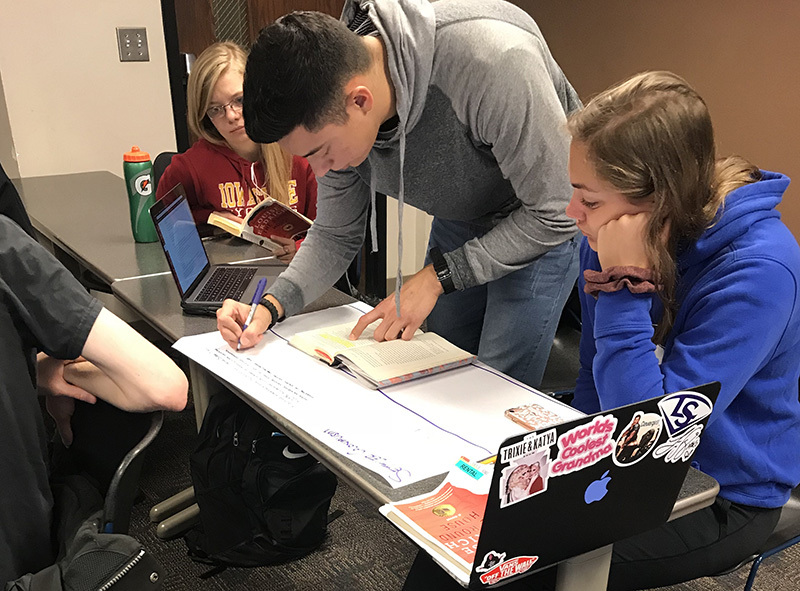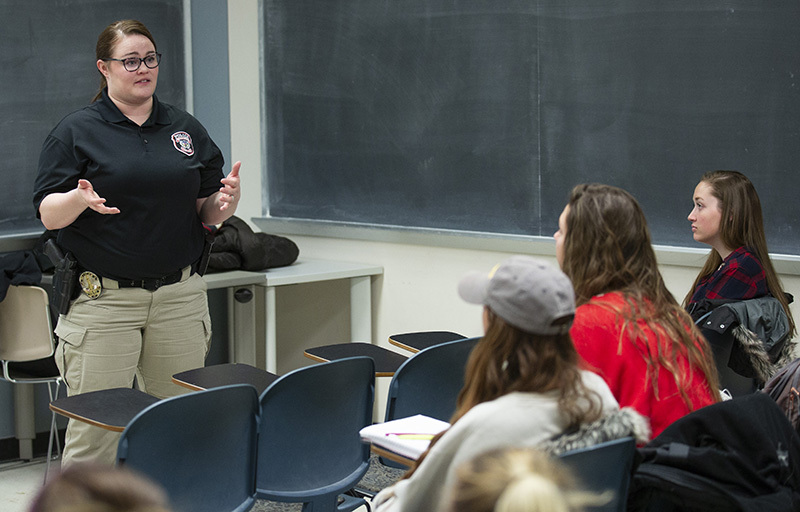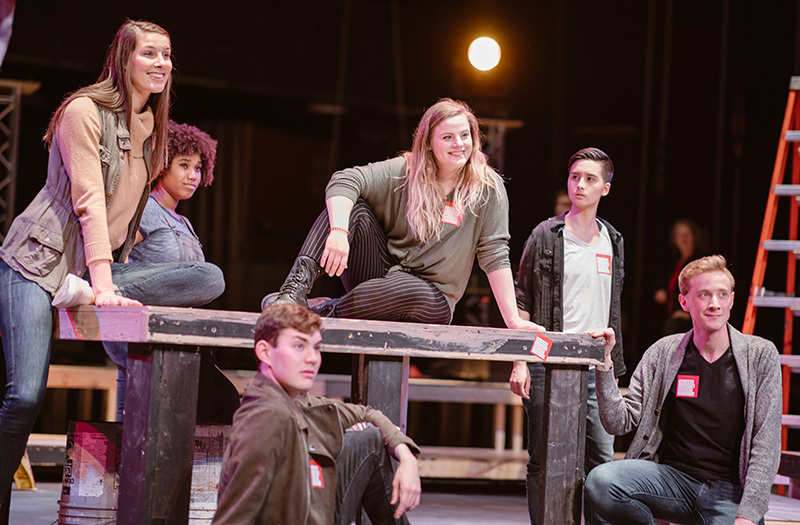(Temporary) campus landmark dismantled

Photos by Christopher Gannon.
The tower crane at the Student Innovation Center construction site, which altered the campus skyline for the last 18 months, came down March 22. Using two other cranes, an aerial-tolerant team from Barnhart Crane and Rigging, Des Moines, took apart the 230-foot structure and, piece by piece, loaded it on flatbed semitrailers for the owner, Blue Hat Hoisting.
The five-level, $84 million Student Innovation Center is about 60 percent complete and on schedule for a spring semester 2020 opening.



Who's on your service delivery team?
Service delivery teams are filling up and the names of individuals who accepted specialist positions are being shared with campus. Specialists will assist departments and units with finance and human resources work in the Workday software system that goes live campuswide on July 1.
A March 28 improved service delivery (ISD) email to employees showed that eight of the 54 human resources positions are open, and 18 of 129 finance jobs still need to be filled. Employees who expressed interest in a specialist role but no longer are being considered have been notified and will be contacted by transition teams for help with their next steps.
ISD training begins next month -- April 1 for HR specialists and April 29 for finance team members. Based on the specialist role, training ranges from 20 to 32 courses (up to 62.5 hours), all of which must be completed before July 1. Summaries of the HR and finance training curricula are available online.
Find out more
The campus email provided links to new resources on WorkCyte's ISD site, including:
- A fact check page, providing accurate information in response to common misconceptions
- An FAQ summarizing the grants process, including the different responsibilities of grants coordinators and grants finance specialists
The website also includes a list of service delivery teams and the units they're assigned to, an FAQ addressing transition concerns, a timeline of upcoming milestones and an archive of campus communications. Questions can be sent to ISD_transition@iastate.edu.
Benefits of open-source, digital course content extend beyond savings

Students in Jen McClung's Native People in American Culture class work on a poster illustrating a theme from one of the course's readings. Photo courtesy of Jen McClung.
Jen McClung and Matthew Clancy both taught classes this year using open educational resources (OER), which are open-license course materials free for students. For the most part, the similarity ends there.
McClung, a senior lecturer in English, designed from scratch lesson plans for a new course, Native People in American Culture, that aimed to keep a class of about 50 students intimate. Clancy's section of Principles of Microeconomics was a lecture for about 270 students that closely tracked the free digital textbook the economics lecturer selected.
For more information
Check out the resources and support available on the new OER website, including personalized consultations, guides for finding and publishing open-license content, a list of ISU faculty who are OER trailblazers and the application for a Miller Open Education mini-grant.
To inquire about the immediate access program, email immediateaccess@iastate.edu.
But there's another parallel that has nothing to do with cost. Both instructors selected their course content exclusively because it fit how they wanted to teach.
Though the financial impact of OER and other affordability initiatives is important, especially as tuition rates continue climbing, it's not their only advantage, said Abbey Elder, open access and scholarly communication librarian. There are significant educational benefits, too. For instance, OER course content can be edited and updated frequently and simply, personalized for teaching styles and accessed by students on the first day of class into perpetuity.
"There are pedagogical reasons why OER is more than just affordable content," Elder said.
Off the (digital) shelf
For years, Clancy had his eye on the free digital textbook he used last fall to teach Econ 101, which saved the students in his course section roughly $30,000.
The book, "The Economy: Economics for a Changing World," came out after his first stint teaching 101 as an Iowa State doctoral student in 2014. Published by a nonprofit, the book emphasizes modern concerns and realistic applications, avoiding the impression that perfect competition is an economic default mode.
"It's sort of a rethinking of what we want to cover and how we want to reflect contemporary issues and economic research," Clancy said. "I just really liked it. It teaches economics the way I like to teach it. If it had cost money, I still would have assigned it."
In addition to its treatment of concepts, the text embraces its electronic nature, he said. Charts and other figures include multiple animated layers, and video examples are common. Teaching from the book reinforced his preference for digital engagement and easy-to-edit text.
"If there are good open-source options, there's no reason why instructors wouldn't want to adopt them," Clancy said. "It's all about the right text. That's what drives people."
From the ground up
Finding a useful textbook always has been elusive for some subjects, and in those courses, OER can be especially appealing because its adaptable and shareable. Clancy is using open-license material to build a new class he's planning on the economics of innovation. McClung did the same last fall when she debuted her new course.
"I pretty much knew I'd have to design my own materials. One of the challenges in this field is the lack of resources," she said.
Designed as a more modern-day version of an American Indian studies introductory course that had seen class sizes grow from the low 30s to 50, McClung incorporated her interests in team-based learning and visual thinking in constructing the semester's six modules.
The team structure gave students a more personal learning environment, which she considers crucial in a class where some cognitive dissonance is expected. The groups identified and illustrated themes in readings, which required them to discuss and translate to imagery their ideas about, say, media coverage of the Standing Rock pipeline protests or Louise Erdrich's novel, "The Round House."
"It succeeded beyond my wildest imagination," McClung said. "In a nonliterature class, I'd say 90 percent read the whole book. That's something teachers dream about."
The flexibility of the course design will keep it current as new issues for native people emerge, she said. "For this discipline, I think that's particularly important, not being locked into a textbook," she said.
Creating a course from the ground up is a heavy lift. McClung said a more piecemeal approach would be preferable, if possible. But she did receive a Miller Open Education mini-grant to help. Applications are open through April 15 for the next round of grants, which can be awarded for identifying, adapting, integrating or creating open-source content.
Ensuring access
While OER saves students money, it's a fraction of the savings generated by the ISU Book Store's immediate access program, which digitally delivers course content from commercial publishers. The content is automatically available to students through Canvas, at steep discounts negotiated by the bookstore. Last fall and this spring, students paid a combined $2.5 million less for those materials than they would for the physical versions, more than double the $1.1 million saved in the fall and spring of 2017-18, according to store data.
Heather Dean, the store's assistant director, said the savings could double again in 2019-20. This year's expansion was driven by adding Pearson, ISU's most-adopted textbook publisher. Pearson joined the second-most popular publisher, McGraw-Hill, which already had a digital delivery contract with the bookstore. Next year, the store expects to add more large academic publishers, making most textbooks eligible for immediate access.
"Then it's just a matter of faculty choice," Dean said. "For faculty, it's about quality of content over price, and it'll always be that way."
As with OER, there's an instructional upside with immediate access. Most importantly, it ensures more students have the book. Students can opt out, but most don't. On average, 96 percent of enrolled students receive the material, Dean said. A typical sales rate for a physical textbook is 60 to 70 percent and even lower for the most expensive offerings, she said -- a feedback loop that helps explain $300 textbooks.
"When 20 percent of the class is buying the book, the price goes up," she said.
The nearly guaranteed sales, and pressure from the growing prominence of OER, incentivize commercial publishers to sell textbooks for less and offer more extras, Dean said. One example is adaptive quizzes and homework that adjust in difficulty to match students' aptitude.
"With those kinds of products, you get some data and analytics to gauge the performance of your class," she said.
Related stories
- CELT, library promote increased use of open educational resources, March 1, 2018
- New Miller grants support better course materials, for free, Sept. 20, 2018
- Instructors can help students save big money, Oct. 25, 2018
University adds Amazon to cyBUY suppliers list
The university's electronic purchasing program, cyBUY, added Amazon to its list of marketplace suppliers. Iowa State's Amazon Business Prime account activated Nov. 1, and since then, about 100 frequent campus users have been added to the account as part of a measured rollout.
Departments may purchase supplies or equipment from Amazon when the 40-plus suppliers currently in cyBUY either don't offer an item or list a higher price on it. Procurement services director Cory Harms said he anticipates frequent use of the Amazon account for one-of-a-kind purchases -- for example, an adult-size tricycle that generates energy in a research project or the dinosaur costumes worn for the marching band's "Jurassic Park" football halftime performance last fall.
Training
Procurement services staff lead a cyBUY Amazon Business Prime training and registration session every week; register via Learn@ISU.
"For items like office and computer supplies and scientific items, we still encourage people to look at our other contracts because they were competitively bid and we want to be fair to those suppliers," Harms said. "Amazon is not always the lowest-cost option for things we've already contracted for, but it is a great option for those nontraditional items the university typically wouldn't have a contract for."
President Wendy Wintersteen applauded procurement services' decision to add Amazon to cyBUY's supplier list. She said ease of purchasing equipment and supplies is an issue that emerged in process improvement discussions during the first year of her presidency.
"I am so pleased with this addition to our electronic purchasing options because many of our faculty and staff suggested it," Wintersteen said. "It's a great example of a change -- accomplished collaboratively -- that will help boost the administrative efficiency in our research and teaching missions."
So long, preapproval
In the past, when departments shopped with Amazon, they received preapproval for their purchases from cyBUY coordinator Ella Wichers and made purchases with the spending limit ($4,900) of an ISU purchasing card.
Harms said user-friendly features of the ISU Amazon Business Prime account are:
- Preapproval no longer needed
- cyBUY's higher purchasing limit of $50,000
- Automatic tax exemption on purchases; no need for special forms
- Free two-day delivery
- No need to use an ISU purchasing card (payment method is preconfigured in ISU's account)
- No need to use a personal Amazon account for work purchases
- Phone access to Amazon's business customer service team
- Additional business discounts may be available on specific products
Departments need to set up an Amazon account the first time they use Business Prime via cyBUY. For some, this process may include deactivating an existing account since Amazon permits one account per email address. Department buyers are asked to attend a campus training session, "cyBUY Amazon Business Training," that includes a 20-minute presentation, assistance setting up an account and access to the Amazon catalog. Procurement services staff also share strategies and lessons learned from initial subscribers on topics such as returns, billing address and documentation in lieu of a packing slip. One to two sessions each week are scheduled this spring; register via Learn@ISU (catalog keyword: cyBUY).
Two years in the making
Harms said his staff studied adding Amazon as a cyBUY supplier for more than two years, and ISU is one of the first schools in the Big 12 Conference to try it. In spring 2017, the department asked a CyBiz Lab student team in the Ivy College of Business to do a broad assessment of the cyBUY program, including functionality and customer satisfaction. Harms said one outcome of the team's work was high interest in a universitywide Amazon account. Independently, Elizabeth Sukup, program coordinator in the president's office, submitted to (at the time) the interim senior vice president for university services a white paper that favorably compared Amazon with other suppliers. Both influenced his department's decision, he said.
Harms said one of his initial reservations about Amazon was whether Iowa State has any leverage if issues arise with sale transactions. With Amazon's high daily sales volume and its use of third-party sellers, he said Iowa State's recourse sometimes is limited.
"When you're spending federal or state money, you want to be very, very careful with it," Harms said.
Iowa State joined an existing contract between Amazon and U.S. Communities, a national purchasing cooperative of nonprofits. Questions about using Amazon through cyBUY may be directed to cyBUY's help desk (email cybuy@iastate.edu or phone 294-8577).
Campus safety options expand as needs evolve

Engagement and inclusion officer Natasha Greene talks about domestic violence and conflict resolution as an invited speaker for a communications studies class. Greene and the ISU Police outreach team coordinate hundreds of requests and events each year. Photo by Christopher Gannon.
Safety is a priority for Michael Newton, which is evident with a look at the initiatives put in place or currently in development since he was appointed chief of police nearly two years ago.
"Safety is ever-evolving," Newton said. "We have to continuously monitor what's working and what's not working. We spend a lot of time evaluating if we need to change directions. Just because something works at one campus, doesn't mean it will work here."
Popular presentations continue to be offered, including self-defense, sexual assault and violent incident response (VIRT) training. Newton kick-started the development of other safety initiatives based on programs he brought from the University of Wisconsin, Madison, and ideas he and his staff picked up from conferences, peers and vendors.
"Our officers are trained to look for problems and find solutions," Newton said. "We are thinking of what else we can do to help our community, because it impacts us. Anything that impacts Ames, impacts us."
ISU Guardian
The latest initiative added to the safety lineup is the ISU Guardian mobile app, which launched March 6. Powered by the company contracted to provide the ISU Alert system, the free safety app was customized for Iowa State and offers a "safety timer" feature that provides users a virtual escort when walking alone. Newton said when GPS is enabled for the app, individuals can designate a "guardian" to alert if they don't make it to their destination on time. During SafeRide hours (6 p.m.-5:30 a.m.), that can be the ISU Police.
"If someone is concerned about walking home at night, we will be able to monitor their progress through the app. If they don't make it home, it will send us an alert and we can send officers to check on them, or we can call them to make sure everything is OK," he said.
A Net-ID is needed to log in to ISU Guardian. Other in-app features include:
- Tip submission
- Call directory of important campus numbers
- One-touch emergency call
- ISU Alert notifications
"If they're using some of those features and have the GPS enabled, we can find their location and where the trouble is," Newton said.
CyWatch
Newton said ISU Police is partnering with the department of residence to develop a CyWatch initiative. Similar to a neighborhood watch program, trained CyWatch volunteers will add a network of eyes and ears focused on campus safety. The initiative, which could expand from residence areas to other campus locations, would include awareness programming to help campus members learn what to watch for and how to be safe.
"This is a way to let the community know that we're all watching out for each other," Newton said. "I can envision us taking this out to academic buildings. We all should be watching out for what's happening."
SafeRide
The SafeRide mobile app -- an Uber-like service aimed at providing safety rides -- launched in August 2016. It offers free campus transportation between 6 p.m. and 5:30 a.m. daily. Riders need a Net-ID to use the SafeRide app and transportation requests are limited to campus locations. Uniformed student community service officers use parking division vehicles (not squad cars) to fulfill requests. More than 23,000 passengers used SafeRide in 2017.
Campus safety walk
Each fall, ISU Police partners with Student Government and facilities planning and management (FPM) staff to tour the campus grounds on the lookout for potential safety issues. Newton said anyone is welcome to join to the fall safety walk, usually held when daylight wanes in October.
Problem areas are identified -- for example, overgrown shrubbery and burned out lights -- then prioritized with input from FPM staff. Newton said issues can be reported to the FPM help desk (294-5100, online form) or police dispatch non-emergency number (294-4428) at any time.
Student advisory board
Newton said he wanted to create a student advisory board before there are issues, rather than in response to them. Student Government appointed the board's first six members last fall, which likely will expand to include an application process for additional members.
Board members gather input from the clubs, organizations and residence areas they're connected to and meet biweekly with Newton to talk about issues and campus safety concerns -- for example, safety in the Greek area, campus lighting and security cameras.
"It's important to get input from the students and give them a direct line to the chief of police," Newton said. "They are passionate about this campus, that's for sure."
Homeless outreach
Newton said homeless individuals often are reported in the intermodal facility and sometimes seek space in campus buildings and camp in wooded areas.
"Our goal is not necessarily to move them out, but to help them find a better option than sleeping outside or sleeping in one of our buildings," Newton said.
Officer Allison Bell recognized the issue and is working on a homeless outreach initiative in partnership with the Ames-based Emergency Residence Project and Ames Police. As part of the program, she collects donated everyday items and string bags to create care kits for the homeless.
"It's early stages and really is a team effort," Newton said. "She's really been pouring her heart and soul into it."
Workday won't make it harder to do business with campus units
Buying goods and services from other campus units will not be more difficult -- or much different -- with Workday, the software Iowa State will use for its finance and human resources work as of July 1.
Learn more
"We do a lot of billing of one another within the university. The process of billing one another isn't going away, it's the terminology for it that won't exist in the future," said Heather Paris, associate vice president for finance and support services. "Workday's internal billing replaces the process within the Kuali Financial System (KFS) system we currently use to generate those charges."
Order like usual
Campus departments provide goods and services that other departments use, for example meeting space, food, equipment and business cards. How departments order those things won't change, and neither will the method departments use to receive and track orders. Much like switching from one credit card to another, buyers and sellers will use Workday worktags instead of account numbers to identify the funding source for purchases.
"The only difference at the front end is using a different number. Instead of the (account) number I'm using now, I'm going to use a new (worktag) number that means the same thing in Workday. It's just structured differently," Paris said.
Help if you need it
Improved service delivery (ISD) teams will be available to help. For example, departments still can order a platter of buttermilk brownies from ISU Dining and rent audiovisual equipment for a meeting in the Memorial Union. ISD specialists can step in to help determine the appropriate Workday worktag or if the employee who usually takes care of ordering is on extended leave.
"If someone who is ordering something needs assistance, specialists within the ISD teams can provide any level of assistance," Paris said.
ISD specialists also will help departments selling goods and services with their back-end work. Currently, billing information is loaded into KFS at the local level. As of July 1, ISD specialists will be responsible for inputting billing information into Workday for the units they serve that provide goods and services.
ISU Theatre presents joyful, exuberant production of 'Godspell'

The "Godspell" cast during rehearsal of the production, which opens April 5 in Fisher Theater. Photo by Britney Walters-Chester.
Join ISU Theatre in a celebration of community and love when it presents the musical "Godspell," opening Friday, April 5, in Fisher Theater. Using a variety of storytelling techniques and a hefty dose of comic timing, a diverse group of 21st-century college students encounter Jesus, who leads them through stories inspired by parables in the Bible's Book of Matthew.
The musical's setting is modern-day, as the performers journey from a discordant group of individuals into a community. The music features inspiring and entertaining songs ranging from pop and rock to vaudeville.
"Godspell" is about a community that comes together out of darkness to create a better tomorrow, said Keaton Lane, senior in journalism and mass communication, who plays the role of Jesus.
"There's a reason that these religious parables and lessons have been used for so long, and it's because they speak to something real and important about what it means to be a human and to struggle every day to be the best version of yourself that you can be," Lane said.
Emily Heckle, a senior in animal ecology cast as a storyteller, said the show's stories have universal relevance.
"Many of the stories included in this show are well-known, but hard to internalize in a present-day context," Heckle said. "Our cast and crew were challenged with the task of creating a work of art that respects the ideas and morals of these parables while making them applicable to a diverse crowd. By adapting the lessons for a modern audience, we are able to tell a story of inclusion, community and love."
The show dissolves hauntingly into the story of Jesus' last meal with his followers before his crucifixion. The new community must then ask what it will do with Jesus' message to make the world a better place.
Brad Dell, director of ISU Theatre the show's director, hopes the audience will be moved by its message of empathy and compassion.
"'Godspell' is an inspiring story for modern times," Dell said. "It's about working together and rising above for the common good and about loving your neighbor to make the world a better place. A central song in the show says, 'We will build a beautiful city, not a city of angels but a city of us.'"
"Godspell" evening performances are April 5, 6, 12 and 13 at 7:30 p.m. Matinee performances are April 7 and 14 at 2 p.m. All performances are in Fisher Theater.
Tickets are available through the Stephens Auditorium ticket office, Ticketmaster or the Fisher Theater box office prior to performances. Tickets are $25 for adults and seniors and $16 for students.
Global Gala provides opportunity to learn about others

Contributed photo.
Fashion, performance and food all can tell a story, and that is the goal of the 14th annual Global Gala on March 29.
Friday's multicultural celebration provides an opportunity to learn about Iowa State student organizations that represent cultures from around the world. They will share their heritage in a fun atmosphere open to the public.
"It is a great way for Iowa State to showcase different kind of cultures and heritage," said sophomore Diego Bonilla, multicultural awareness co-director for the Student Union Board. "I think it is important to be able to show some of the cultures represented on campus at Iowa State."
Bonilla said organizations will use a variety of ways to showcase their cultural diversity, including music, dance and clothing. The Pakistan Student Association, Descarga Latin Dance Club, Motion Sickness Dance Team and Brazilian Student Organization are a few of the participating organizations.
"This is just a cool event people can enjoy and learn from," Bonilla said.
The menu will feature food from different parts of the world, including vegetarian and gluten-free options. Bonilla said a large map will allow attendees to "pin" their home country.
Doors to the Memorial Union Great Hall open at 6 p.m. and the program begins at 7 p.m. Admission is free and open to the public.

